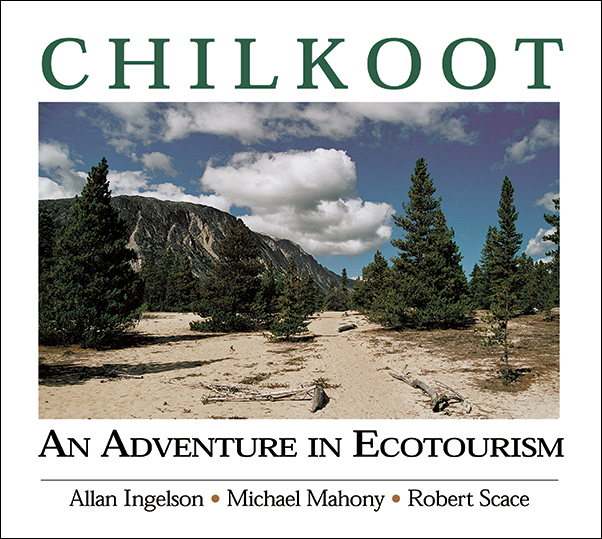
Chilkoot: An Adventure in Ecotourism
Allan Ingelson, , Mike Mahoney, and , Robert Scace
$34.95 CAD / $34.95 USD (S)
264 pages, 133 illustrations
9.5 x 8.5 inches
Paperback: 978-1-55238-030-7
October 2001
Hike the Chilkoot Trail with three experts to discover the amazing history of the trail from Tlingit trade route to Klondike Gold Rush route, learn how it is a classic example of modern ecotourism, and experience its vast and varied natural beauty.
A trail book unlike any other, Chilkoot: An Adventure in Ecotourism is a richly woven insight into the Chilkoot Trail and the region straddling the American-Canadian border in the Alaska and British Columbia.
The authors present the trail in three interrelated parts. They begin by describing the trail as a classic example of modern ecotourism with reference to management practices and user expectations, responses, and satisfaction. Then they show the amazing history of the trail. They conclude with an illustrated presentation of their own experiences. The Chilkoot has a long and varied history: it was an important trade route of the coastal Tlingit people; it attracted worldwide notoriety during the frantic Klondike Gold Rush days; and now it has an international reputation among recreational hikers.
Today, Chilkoot is an icon. It is thirty-three miles (53 km) of dense forest, rugged mountain, golden sand dune, rushing river, and sylvan lake settings stretching from Alaskan salt tidewater to freshwater Lake Bennett at the headwaters of the Yukon River in British Columbia. Rich in natural and cultural history and protected entirely as parkland, the Chilkoot forms a major portion of the extensive Klondike Gold Rush International Historical Park.
Allan Ingelson, formerly an associate curator with the Glenbow Museum in Calgary, Alberta, has lectured at the University of Calgary since 1991. His research interests include environmental regulation, cultural and historical resource management, and natural resources law.
Micheal Mahony, a freelance photographer and avid hiker, has photographed flora and fauna in western and northern Canada, the United States, and the Philippines.
Robert Scace, a geographer and practising environmental consultant for over thirty years, has studied a spectrum of environments, from the urban and industrialized to the wild and uninhabited. He has an abiding personal and professional interest in planning, management, human use, and facility assessment in national and historic parks, heritage river corridors, and other valued heritage landscapes.
Acknowledgements
Introduction
Unveiling a Triptych
Hiking the Trail Today: An Overview
Part One: The Chilkoot and Ecotourism
Getting a Fix on Ecotourism
The Chilkoot Trail
Recreational Visitors on the Chilkoot Trail
Summer Use
Winter Use
Ecotourism Challenges
Part Two: The Trail in History
First Nations and the Chilkoot
Early Eighteenth– and Nineteenth&ndahsh;Century Trade Alliances
The Tinglit Trade Network and the Chilkoot Trail
A Change of Economy
Klondike Diversity: An International Stampede
Dangers of the Chilkoot Pass
The Tidewater Communities
Whose Trail Anyway?
Tourism as History
Heritage Interationa
Part Three: Along the Chilkoot Trail
A Diverse Landscape: From Salt Water to Barren Scree
Trailhead to Finnegan’s Point
Finnegan’s Point to Canyon City
Canyon City to Pleasant Camp
Pleasant Camp to Sheep Camp
Sheep Camp to Chilkoot Summit
Chilkoot Summet to Happy Camp
Happy Camp to Lindeman City
Lindeman City to Bennett
Bennett: The End of the Trail
Leaving the Trail: Bennett to Skagway\Whitehorse
Appendix: Planning to Visit, Planning to Hike?
Bibliography
Index
About the Authors
A delightful book . . . Not only is it a fine trail guide, but it also works very well in showing how good ecotourism opportunities and practices can be successfully created and managed to the benefit of today’s visitors.
—Robert King, Alaskan Anthropology
Chilkoot: An Adventure in Ecotourism is successful as a simple trail guide, and as a work with higher goals of displaying how good ecotourism practices are carried out. The authors hold up the Chilkoot Trail as a shining example of ecotourism, a strong collaboration of state and national governments and the local community in protecting, promoting and managing a historically and environmentally significant area.
—Fred Manson, Electronic Green Journal